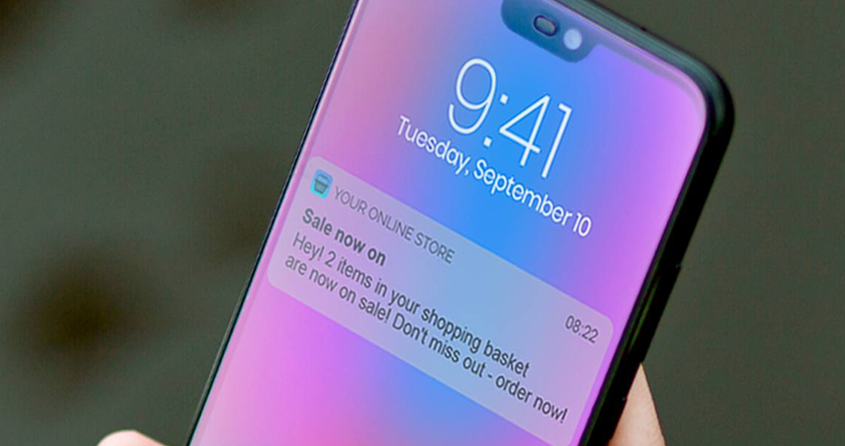Generating more than $4.9 trillion in sales every year, e-commerce is a thriving industry. Yet to succeed, businesses globally must overcome a sizeable hurdle: shopping cart abandonment. Recent research reveals that more than 69% of transactions are abandoned without completion.
This equates to an estimated $4.6 trillion in lost sales each year. The good news is approximately $2.75 trillion of this is recoverable through meaningful remarketing strategies and improved mobile messaging.
Read on to learn the main reasons for cart abandonment and how mobile apps can retarget and nudge users toward completing their purchases using recovery push notifications.
Why is shopping cart abandonment a problem for retailers?
It’s hard work enticing users to download your e-commerce app, so when they express even further interest by adding something to their shopping cart, you want to do everything you can to maximize the chances of conversion.
But what happens when the user lapses and fails to complete the transaction? Which is most of the time, by the way.
Your first goal is to determine why your customers failed to complete the purchase. You know they are somewhat interested, given they added the item to their cart in the first place. So, it will be easier to convert these users than those who have just started browsing your store.
Essentially, these shoppers are indirectly telling you what they are interested in and are letting you know something is holding them back. It’s your job to find out what that is.
Price and unexpected costs
Nobody likes paying for shipping on top of the items they wish to purchase, particularly if those costs have not been disclosed early on. Any kind of hidden fee like this is an unpleasant surprise for customers. Research shows that more than 60% of customers at least consider abandoning their order because shipping isn’t free.
To rule out shipping costs as a reason for cart abandonment, make it known early on what the customer can expect to pay for shipping. Consider offering free shipping wherever possible. For example, when a customer spends over a certain amount, is a member of your rewards program, or lives within a certain radius. In most cases, the added long-term value of gaining more customers will outweigh the shipping costs you have to cover.
Poor or complicated process
Optimize your checkout process to be as efficient and short as possible without any unnecessary extra steps. A lengthy process requesting excessive information is an easy way to turn customers away.
Customers today are wary of how businesses use their information, so asking for details unrelated to their purchase could cause them to refrain from ordering—for example, insisting users create an account to complete their purchase or subscribe to a newsletter. These additional steps can create roadblocks for the user who has one goal—completing their order.
As for the information you do need to collect to fulfill the customer’s order, it can help to communicate that it will only be used for this purpose.
Security concerns
Customers are not just wary about handing over personal information. They’re also concerned about overall site security and can be reluctant to purchase from an app or website they feel is not secure. Make it clear in your messaging during the payment stage in particular that customers’ details are safe and secure.
Once you have found the root cause of why users are abandoning their carts, you can start working towards getting them back to your app to complete their purchase.
Abandoned cart recovery push notifications
What kind of push notification campaigns can you start launching to encourage potential buyers to complete their purchases?
Send a promotional offer
Target audience: the passive shopper
Sometimes users want the products they add to their shopping cart, but not quite enough to complete the purchase at that moment. Maybe the price is too high, they don’t urgently need the item, or they’re saving it in their basket to purchase later on. Or maybe the user is searching other stores for the same product at a lower price and might return if your price is right.
In these scenarios, a push notification that includes an incentive such as a discount or promo code can be powerful for enticing an unsure buyer to complete a purchase.
The example below combines a discount with clever copy relating to the cart product to increase the chances of grabbing users’ attention.
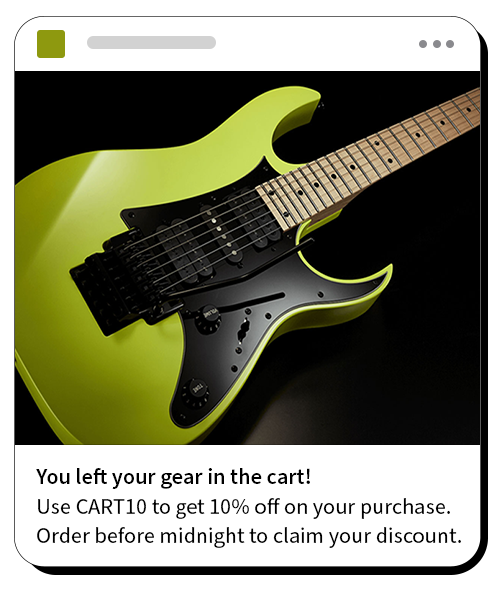
Combine this with another tactic such as urgency and a clear call to action to maximize reengagement and encourage the buyer to swiftly take action. Time-sensitive promotions like the one below can convert users faster and tend to see higher success rates.
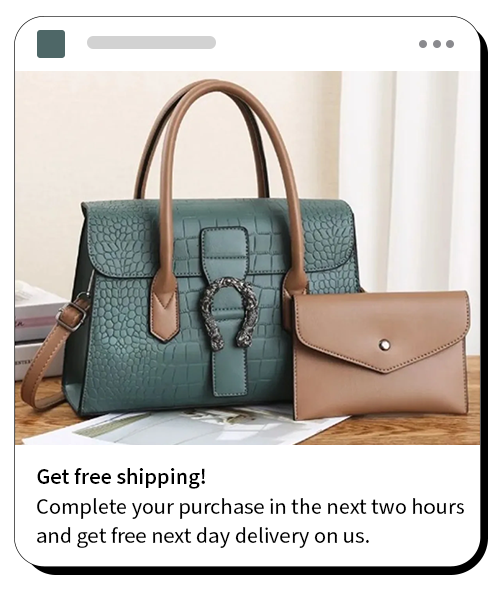
Offering a percentage discount on price-elastic products can also be highly effective.
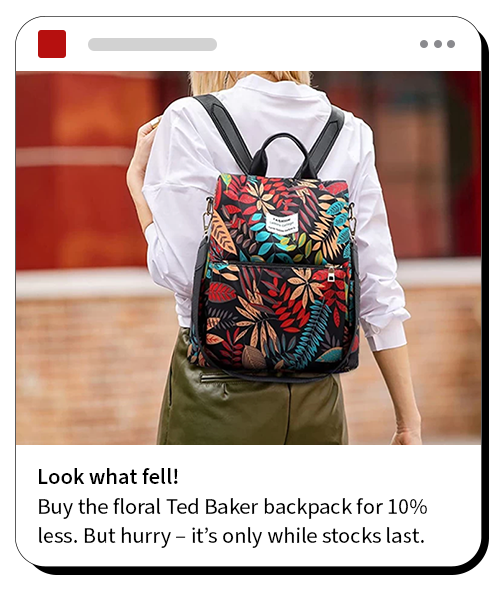
According to Statista, 47% of customers abandon their cart due to high shipping costs, so it makes sense to offer free shipping if it means converting those customers—if it’s still profitable, of course.
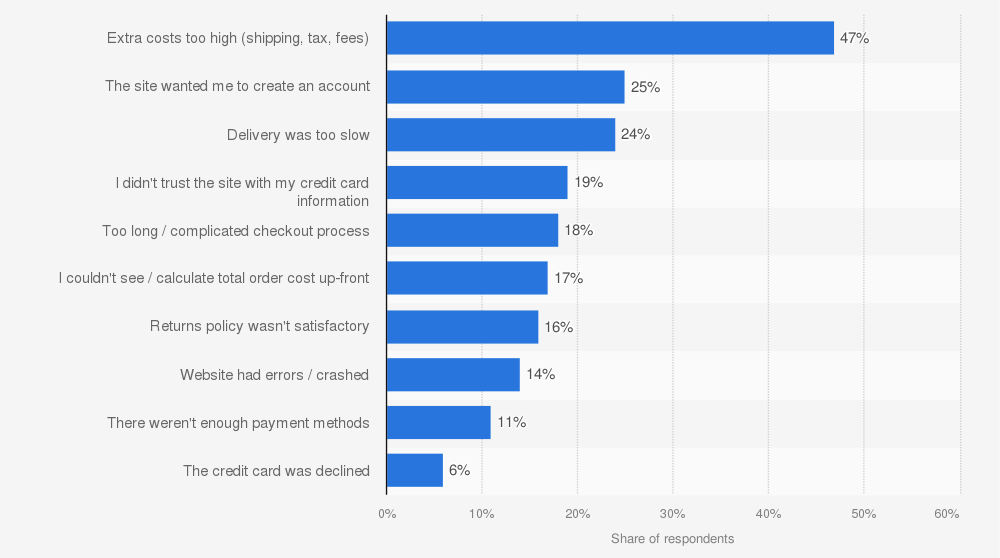
Add a free delivery campaign to your abandoned cart strategy and analyze the results and ROI to determine its effectiveness. Cost incentives like these are a great way to capture price-sensitive buyers, which most of those leaving items in their cart likely are.
Create a sense of urgency
Target audience: the wishlist shopper
Many of us are guilty of using shopping carts as wish lists, so we don’t forget what we wanted later on. This is particularly common in the retail space. Again, we like the products we add but there’s often no real urgency or, in some cases, a solid intention to actually buy them. And if the cart doesn’t expire, we just leave the items there, planning to return (or, let’s be honest, forgetting) at our convenience.
Here is where a limited-time price incentive or notification about stock running low on a particular item can encourage a user to make a move. The key is to create urgency and a sense of FOMO around the transaction.
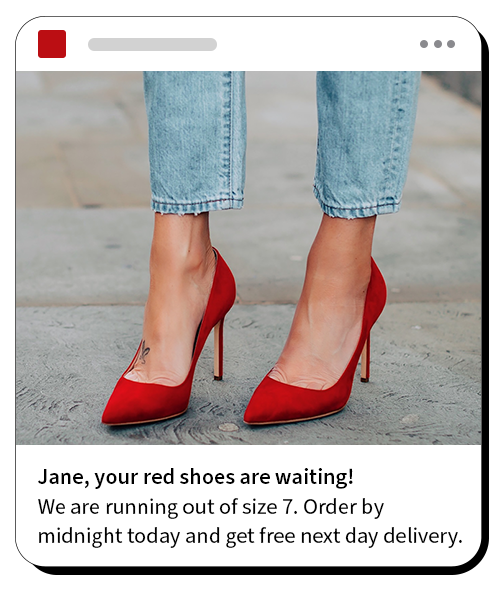
Alert your customers that the item they’re interested in is either low in stock or being held in their cart for only a brief time. And if feasible, add a promo code or price incentive to sweeten the deal.
Send a reminder
Target audience: the forgetful shopper
Although not as common a reason for abandoning a shopping cart, interruption and distraction do happen while shopping online and can be easily solved by subtly reminding users they have something in their cart.
The lighthearted wording in Jet’s push notification below acknowledges that sometimes you just get distracted and forget to finish checking out. They nicely position their reminder as a friendly nudge.
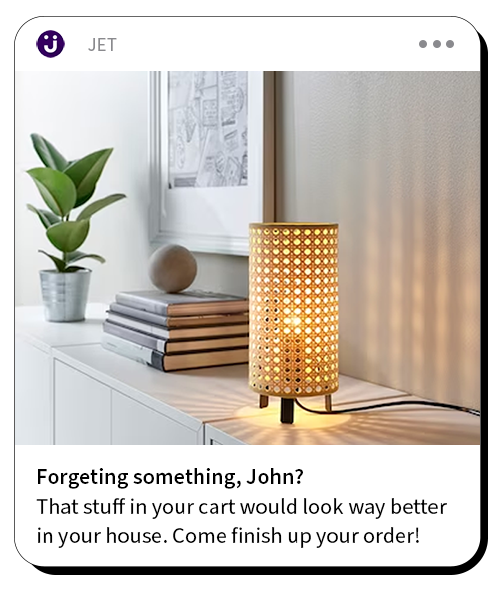
Sending a simple reminder letting customers know they forgot something in their cart can sometimes be enough to get them to return and complete the transaction. If not, you can always follow up with urgency or a promotional incentive notification. This way, you can be sure you’re not distributing discounts unnecessarily and fully protect your profit margins.
While it is more likely, it’s important not to instantly assume the abandonment is a matter of price but may simply be an unintentional interruption while making a purchase. Many customers have high purchase intent and leave the website, hoping they remember to return later and finish their order.
This subset of users simply needs a gentle reminder of what they loved on your website to persuade them to complete their purchase.
Align purchase intent
How will the product improve the customer’s life? Think about the benefits of a particular product and use that to help close the sale.
Most customers shop for items to solve a particular pain point. Whether that’s looking great for a party or getting a better night’s sleep, reminding them that your product will help them achieve these things is a great way to convince them to return to your app and finish their purchase.
Ask for feedback and offer help
If you are seeing a higher frequency of cart abandonments, you might want to ask customers for feedback to get to the root of the problem. As price isn’t the only reason a customer leaves without purchasing, presenting a brief survey can help identify patterns that you can then use to improve your process, user experience and ultimately, conversion rate.
Use customer responses as an opportunity to offer support and guide them through the rest of the checkout process.
Personalize your push notifications
More and more people are beginning to dislike generic messages and demand personalization at every stage of the buyer’s journey. Personalization is vital for engaging users and grabbing their attention among the noise of every other marketing communication.
Abandoned cart emails and notifications are a dime a dozen these days, with most simply listing the items left in the cart—boring, generic, and easily ignored. Instead of a basic reminder of a product in a cart, call out the specifics. Add the name of the customer and the product they were interested in purchasing.
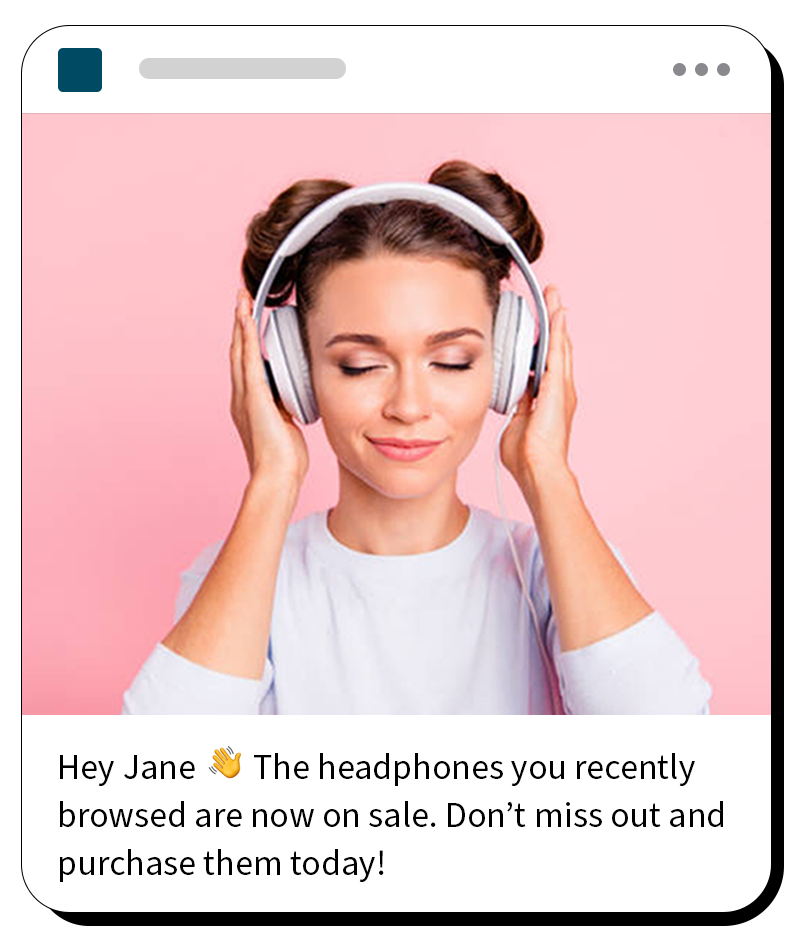
That same user may have abandoned carts on multiple apps and websites, so personalizing your messaging will help them quickly make the association with your brand.
Be as specific to where the user was in the checkout process as possible. By matching your notifications to where their decision went from a ‘Yes’ to a ‘No,’ you’ll be able to sway them seamlessly back into the funnel.
You want to create lifetime customers, so significant effort should go into personalizing notifications. Go a step further with contextualization and tell the user how “those red shoes would pair perfectly with that black dress you bought last month,” or refer to the user’s unique account details like the example below.

Data shows that customers engage with personalized messages at a 4–7x higher rate than generic, non-personalized messages, so if and when you can personalize, you should.
Get the timing of your notifications right
Timing is crucial when it comes to sending notifications—it can be the difference between converting a user and annoying them. Sending an alert right after the customer leaves the app can be counterproductive and irritates most users. On the flip side, if you wait too long, the customer might have already made a purchase elsewhere or changed their mind. So, finding the right balance is key.
Based on our research, the recommendation is to give customers at least a 30-minute window after they abandon their cart to return and complete their purchase. If they haven’t converted within that timeframe, you can nudge them with your first recovery notification.
Build high-converting abandoned cart campaigns
Push notifications are a remarkably effective sales recovery channel. Using push, you can effortlessly reclaim abandoned carts by offering personalized discounts, creating a sense of urgency, instilling FOMO, and providing support.
Mobile users face a constant barrage of marketing messaging and notifications every day. To cut through the noise, let the customer data you collect, particularly the insights that help you understand why a user abandons their cart, guide your campaigns.
With MessageGears’ push notification solution, you can deep-link directly to the cart at the precise point a user abandoned, removing friction and maximizing the likelihood of a conversion. The campaign builder is a simple drag-and-drop interface, designed for marketers and easy to use.
Schedule your personalized demo to learn how MessageGears can power your mobile marketing to deliver sophisticated abandoned cart campaigns without the need for designers, developers, or everyone in between.
